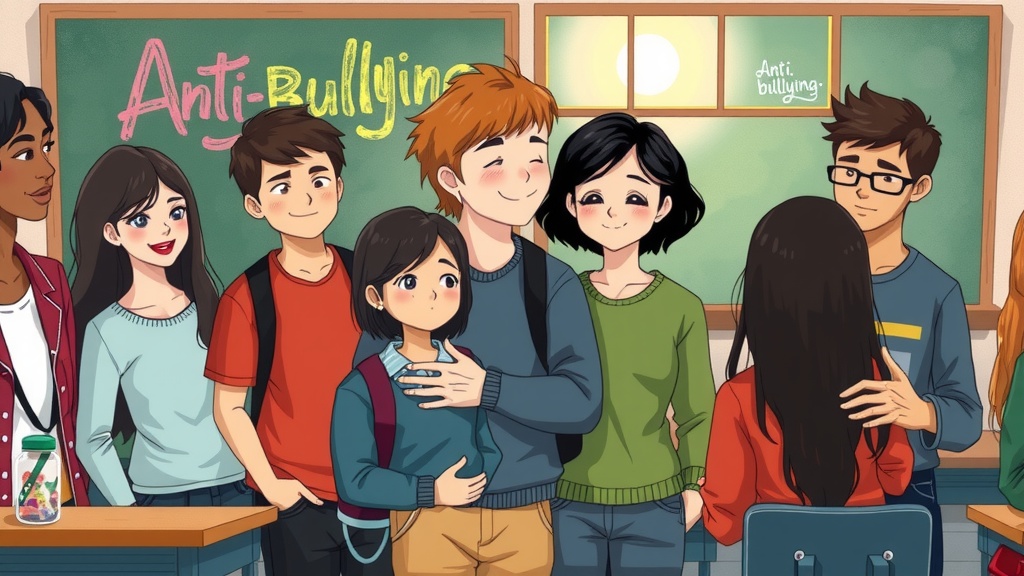Bullying Paragraph for Class 6-12, SSC, HSC, 150, 250, 300 Words
Have you ever felt that knot in your stomach, that feeling of dread before going to school? Sometimes, that feeling isn't just about a test; it’s about something much bigger: bullying. Bullying isn't just "kids being kids." It's a serious problem that affects students of all ages, backgrounds, and levels of education, from Class 6 all the way through HSC. Let's break down what bullying is, why it happens, and what we can do about it, specifically tailored for students in Bangladesh.
What is Bullying? (150 Words)
Bullying is when someone intentionally and repeatedly hurts or intimidates another person. It's not just a one-time thing; it's a pattern of behavior. This can take many forms. Think of it like this: imagine a younger sibling constantly teasing an older one, not in a playful way, but in a way that makes them feel small and worthless.
Bullying can be physical, like hitting or pushing. It can be verbal, like name-calling or making threats. It can also be social, like spreading rumors or excluding someone from a group. And in today's world, it can be cyberbullying, which involves using technology like phones or the internet to harass someone. The key thing to remember is that bullying involves a power imbalance where one person feels helpless and targeted.
Bullying এর সংজ্ঞা (Bullying Definition in Bangla)
শারীরিক, মানসিক বা সামাজিকভাবে দুর্বল কাউকে ইচ্ছাকৃতভাবে বারবার আঘাত করা বা ভয় দেখানোকে বুলিং বলে। এটা শুধু একবারের ঘটনা নয়, বরং আচরণের একটি ধারাবাহিকতা।
Types of Bullying: More Than Just Physical Fights
Bullying isn't just about playground scuffles. It's a chameleon, taking on different forms to inflict pain. Understanding these forms is the first step in combating them.
Physical Bullying
This is the most obvious type: hitting, kicking, pushing, or damaging someone's belongings. It's a direct assault on a person's physical safety. Imagine someone snatching your pen in class and breaking it just to see you upset – that's physical bullying.
Verbal Bullying
Words can hurt just as much as fists. Name-calling, insults, threats, and taunts all fall under verbal bullying. Think about being constantly called names because of your appearance or your family's background. These words can chip away at a person's self-esteem.
Social Bullying
Also known as relational bullying, this involves damaging someone's reputation or social standing. Spreading rumors, excluding someone from a group, or turning others against them are all forms of social bullying. Imagine being deliberately left out of a group project or having lies spread about you online.
Cyberbullying
The digital age has brought a new form of bullying: cyberbullying. This involves using technology like social media, text messages, or emails to harass, threaten, or embarrass someone. Cyberbullying can be particularly damaging because it can reach a wide audience and be difficult to escape. Imagine receiving hateful messages online or having embarrassing photos shared without your consent.
Cyberbullying Examples
- Harassment: Sending offensive or threatening messages.
- Denigration: Posting false or damaging information about someone.
- Exclusion: Intentionally excluding someone from an online group or activity.
- Outing: Sharing someone's secrets or embarrassing information online.
- Trickery: Tricking someone into revealing personal information and then sharing it.
Why Does Bullying Happen? Understanding the Root Causes
Bullying is a complex issue with no single cause. Several factors can contribute to why someone becomes a bully. Understanding these factors can help us address the problem more effectively.
Power Imbalance
At the heart of bullying is a power imbalance. Bullies often target those they perceive as weaker or less able to defend themselves. This power can be real or perceived, based on physical strength, social status, or even access to information.
Social Environment
The social environment plays a significant role in shaping behavior. Schools or communities where bullying is tolerated or even encouraged are more likely to have a problem. Peer pressure can also influence individuals to participate in bullying, even if they know it's wrong. Imagine a group of friends who constantly tease one particular classmate. Someone who might not normally engage in bullying might join in to fit in with the group.
Family Dynamics
Family dynamics can also contribute to bullying behavior. Children who witness or experience violence at home may be more likely to become bullies themselves. Similarly, children who lack parental supervision or who are not taught empathy may be more prone to bullying.
Lack of Empathy
Bullies often lack empathy, the ability to understand and share the feelings of others. They may not realize the harm they are causing or may simply not care. This lack of empathy can stem from a variety of factors, including upbringing, personality traits, or even mental health issues.
Seeking Attention
Some bullies may engage in bullying behavior to gain attention or status. They may see it as a way to impress their peers or to feel powerful. This can be particularly true in social media, where bullies may seek likes and shares for their actions.
The Impact of Bullying: More Than Just Hurt Feelings (250 Words)
Bullying isn't just a schoolyard problem; it has serious and long-lasting consequences for both the victim and the bully. For the victim, bullying can lead to anxiety, depression, low self-esteem, and even suicidal thoughts. It can also affect their academic performance, making it difficult to concentrate in class or even attend school. Imagine a student who is constantly being harassed online. They might become withdrawn, avoid social situations, and struggle to keep up with their schoolwork.
The effects of bullying can extend into adulthood, affecting relationships, career prospects, and overall well-being. Bullies, too, can suffer negative consequences. They are more likely to engage in criminal behavior, have difficulty maintaining relationships, and struggle with mental health issues. Bullying is a cycle of harm that needs to be broken.
বুলিংয়ের প্রভাব (Impact of Bullying in Bangla)
বুলিংয়ের শিকার হওয়া ব্যক্তি উদ্বেগ, হতাশায় ভুগতে পারে, আত্মবিশ্বাস কমে যেতে পারে, এমনকি আত্মহত্যার চিন্তাও আসতে পারে। এছাড়া, পড়াশোনায় মনোযোগ কমে যাওয়া এবং স্কুলে যেতে অনীহা দেখা দিতে পারে। বুলিং শুধু একটি স্কুল-বিষয়ক সমস্যা নয়; এটি শিকার ও নির্যাতনকারী উভয়ের জন্যই দীর্ঘমেয়াদী নেতিবাচক প্রভাব ফেলে।
What Can We Do About Bullying? Taking Action Together (300 Words)
Combating bullying requires a collective effort from students, teachers, parents, and the community as a whole. If you are being bullied, the first step is to tell someone you trust, whether it's a parent, teacher, or friend. Don't suffer in silence. It's also important to document the bullying, keeping records of dates, times, and specific incidents.
Schools need to implement comprehensive anti-bullying programs that include clear policies, reporting procedures, and consequences for bullying behavior. These programs should also focus on teaching empathy and promoting positive relationships. Parents can play a crucial role by talking to their children about bullying, teaching them how to recognize and respond to it, and monitoring their online activity.
Bystanders, those who witness bullying, also have a responsibility to act. Speak up against bullying, support the victim, and report the incident to an adult. Remember, silence is complicity. Together, we can create a culture of respect and kindness where bullying is not tolerated.
বুলিং প্রতিরোধে আমাদের করণীয় (What We Can Do to Prevent Bullying in Bangla)
বুলিং প্রতিরোধে ছাত্র, শিক্ষক, অভিভাবক ও সম্প্রদায়—সবার সম্মিলিত প্রচেষ্টা প্রয়োজন। বুলিংয়ের শিকার হলে, প্রথম কাজ হলো বিশ্বস্ত কাউকে জানানো। এছাড়া, বুলিংয়ের ঘটনাগুলো তারিখ, সময় ও বিস্তারিত তথ্যসহ লিখে রাখা উচিত। স্কুলগুলোতে বুলিংবিরোধী কর্মসূচি চালু করা উচিত, যেখানে সুস্পষ্ট নীতিমালা, অভিযোগ জানানোর পদ্ধতি এবং বুলিং আচরণের পরিণতি সম্পর্কে উল্লেখ থাকবে।
Bullying in the Bangladesh Context: Unique Challenges and Solutions
While bullying is a universal problem, it manifests differently in different cultural contexts. In Bangladesh, certain factors can exacerbate the issue, such as social hierarchies, economic disparities, and limited access to resources.
Social Hierarchies
Bangladeshi society, like many others, has its own social hierarchies based on factors like family background, wealth, and academic achievement. These hierarchies can create opportunities for bullying, where those in positions of power target those who are perceived as lower in status.
Economic Disparities
Economic disparities can also contribute to bullying. Children from wealthier families may bully those from poorer families, or vice versa. This can manifest in the form of teasing about clothing, possessions, or access to opportunities.
Limited Access to Resources
Limited access to resources, such as counseling services or mental health support, can make it difficult for victims of bullying to cope with the trauma. Schools in Bangladesh may not have the resources to implement comprehensive anti-bullying programs or to provide adequate support to students who are being bullied.
Cultural Norms
Certain cultural norms can also contribute to the problem. For example, there may be a stigma associated with reporting bullying, or a belief that it is simply "part of growing up." This can make it difficult for victims to come forward and seek help.
Solutions for the Bangladesh Context
Addressing bullying in Bangladesh requires a multi-pronged approach that takes into account these unique challenges. This includes:
- Raising Awareness: Educating students, parents, and teachers about the different forms of bullying and its impact.
- Promoting Empathy: Teaching empathy and respect for others, regardless of their background or status.
- Strengthening School Policies: Implementing clear anti-bullying policies and procedures in schools.
- Providing Support Services: Ensuring access to counseling and mental health support for victims of bullying.
- Engaging the Community: Involving community leaders, religious figures, and NGOs in anti-bullying efforts.
Real-Life Examples of Bullying in Bangladesh
To illustrate the prevalence and impact of bullying in Bangladesh, let's consider some real-life examples:
- Case 1: A student from a rural area is constantly teased by classmates for their accent and clothing.
- Case 2: A student who is struggling academically is ostracized by their peers and called names.
- Case 3: A student who is openly gay is subjected to homophobic slurs and threats.
- Case 4: A student is cyberbullied on social media after a private photo is shared without their consent.
These examples highlight the diverse forms that bullying can take and the devastating impact it can have on victims.
The Role of Parents in Preventing and Addressing Bullying
Parents play a crucial role in preventing and addressing bullying. They can:
- Talk to their children about bullying: Have open and honest conversations about what bullying is, how to recognize it, and what to do if they are being bullied or witness bullying.
- Teach empathy and respect: Model respectful behavior and teach their children to treat others with kindness and compassion.
- Monitor their children's online activity: Be aware of what their children are doing online and who they are interacting with.
- Encourage their children to report bullying: Let their children know that they can come to them if they are being bullied or witness bullying.
- Work with the school: If their child is being bullied, work with the school to address the issue and ensure their child's safety.
The Role of Teachers in Creating a Safe and Supportive Environment
Teachers also play a vital role in creating a safe and supportive environment where bullying is not tolerated. They can:
- Establish clear classroom rules: Set clear expectations for behavior and consequences for bullying.
- Model respectful behavior: Treat all students with respect and kindness.
- Intervene when they witness bullying: Take immediate action to stop bullying behavior.
- Teach empathy and conflict resolution skills: Help students develop the skills they need to resolve conflicts peacefully.
- Create a culture of inclusivity: Foster a classroom environment where all students feel valued and respected.
Frequently Asked Questions (FAQs) About Bullying
Let's tackle some common questions about bullying to provide further clarity and guidance.
What is the legal definition of bullying in Bangladesh?
Unfortunately, Bangladesh doesn't have a specific law solely dedicated to defining and punishing bullying. However, certain actions related to bullying, like physical assault or harassment, can be addressed under existing laws such as the Penal Code. There's a growing need for specific legislation to address bullying effectively.
What are the signs that my child is being bullied?
It can be tough to tell if your child is being bullied, as they might be afraid or ashamed to speak up. Look out for these signs:
- Sudden changes in mood or behavior
- Reluctance to go to school
- Unexplained injuries or missing belongings
- Changes in sleep or eating habits
- Withdrawal from social activities
- Anxiety or depression
What should I do if my child is bullying others?
It's crucial to address the issue head-on if you discover your child is bullying others.
- Talk to your child about their behavior and explain why it's wrong.
- Help them understand the impact of their actions on others.
- Set clear expectations and consequences for bullying behavior.
- Seek professional help if needed.
- Work with the school to address the issue.
How can schools create a more bully-free environment?
Schools can take several steps to create a safer environment:
- Implement comprehensive anti-bullying policies.
- Provide training for staff on how to recognize and respond to bullying.
- Promote a culture of respect and inclusivity.
- Encourage students to report bullying.
- Provide support services for victims of bullying.
- Involve parents and the community in anti-bullying efforts.
Is cyberbullying more harmful than traditional bullying?
Cyberbullying can be particularly harmful because it can be relentless, anonymous, and reach a wide audience. It can also be difficult to escape, as it can follow victims home and into their personal lives. However, all forms of bullying can have serious consequences, and it's important to address them all.
Table: Comparing Bullying Types
| Type of Bullying | Description | Examples | Impact |
|---|---|---|---|
| Physical | Involves physical harm or damage to property | Hitting, kicking, pushing, stealing | Physical injuries, fear, anxiety |
| Verbal | Involves the use of words to hurt or intimidate | Name-calling, insults, threats, taunts | Low self-esteem, depression, anxiety |
| Social | Involves damaging someone's reputation or social standing | Spreading rumors, excluding someone from a group | Isolation, loneliness, depression |
| Cyberbullying | Involves the use of technology to harass or threaten | Sending hateful messages, posting embarrassing photos online | Anxiety, depression, fear, reputational damage |
Practical Tips for Students Facing Bullying
If you're facing bullying, remember you're not alone. Here are some practical tips:
- Tell Someone: Reach out to a trusted adult – a parent, teacher, counselor, or relative.
- Document Everything: Keep a record of each incident, including dates, times, and details.
- Stay Safe Online: Block bullies on social media and report cyberbullying to the platform.
- Build a Support System: Spend time with friends and family who make you feel good about yourself.
- Practice Self-Care: Engage in activities that help you relax and de-stress, like listening to music or spending time in nature.
- Don't Retaliate: Responding with violence or aggression will only escalate the situation.
- Remember Your Worth: Bullying is never your fault. You deserve to be treated with respect.
The Power of Empathy: Walking in Someone Else's Shoes
Empathy is the ability to understand and share the feelings of another. It's a crucial ingredient in preventing bullying. When we can put ourselves in someone else's shoes and understand how our actions might affect them, we're less likely to engage in bullying behavior.
How to Develop Empathy
- Listen Actively: Pay attention to what others are saying and try to understand their perspective.
- Ask Questions: Ask questions to clarify your understanding and show that you care.
- Imagine Their Feelings: Try to imagine how someone else might be feeling in a particular situation.
- Show Compassion: Offer support and encouragement to those who are struggling.
- Challenge Your Biases: Be aware of your own biases and try to see things from different points of view.
Beyond the Paragraph: Creating a Bully-Free Future
Writing a paragraph about bullying is just the first step. Creating a truly bully-free future requires ongoing effort and commitment from all members of society. It requires us to challenge harmful norms, promote empathy and respect, and create safe and supportive environments for all.
So, let's not just write about bullying; let's act against it. Let's be the change we want to see in the world. Let's stand up for those who are being bullied and create a future where everyone feels safe, valued, and respected.
Bullying is a serious issue that affects students in Bangladesh and around the world. By understanding the different forms of bullying, its causes, and its impact, we can take action to prevent it and create a more positive and supportive environment for all. Remember, whether you're a student in Class 6, preparing for your SSC, or studying for your HSC, you have the power to make a difference. Speak up, stand up, and be the change!




